 |  |
By Tom Gatch
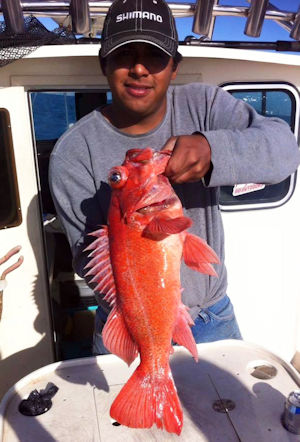
Our post El Niño warmth in 2017 has been predicted to carry over for several months here in the southwest. However, the New Year was still ushered in by a series of storms, which smacked both southern California and northern Baja.
Luckily, however, the weather between these types of occasional systems has generally been spring like, allowing for some excellent saltwater fishing opportunities out on the water.
While there may be a seasonal moratorium on taking most types of ground fish in southern California this time of year, such is not the case south of the border. Southcoast anglers who enjoy winter bottom fishing for species like lingcod, cow cod and a plethora of other tasty rockfishes in the Sebastes family will find that the rich waters between the Coronado Islands and Bahía San Quintín offers them unobstructed access to multitudes of these popular fish.
Large California sheephead have also been readily inhaling baits in areas situated between kelp beds and rocky structures; and so far seem to be showing up more in catch reports this year than last. If you want to specifically target them, try baiting up with squid, mussels or even whole shrimp from the fish market on a single hook fluorocarbon dropper loop.
Sportfishers and pangas working out of the Port of Ensenada have had their best luck fishing around Islas Todos Santos, and the deeper waters of the Banda Bank. South of town, Vonny’s Fleet Pangas report steady catches of various rockfish along with occasional sheephead, medium sized white seabass and yellowtail.
Further down the road in Bahía San Quintín, private boaters and local pangeros are picking up some quality grade yellowtail, which have been supplemented by a variety of the large lingcod, Pacific red snapper and the other plentiful rockfish for which this region has become renowned.
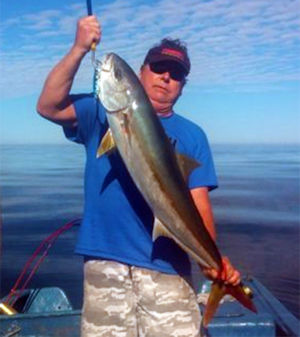
On Isla Cedros, just off the coast of central Baja, Jose Angel at Cedros Outdoor Adventures reports that it is now official; after years of concerted effort, the islands of Cedros and San Benito have been included in a natural protected area adjacent to El Vizcaino Biosphere Reserve. This action creates a safeguard against commercial intrusion, and helps to ensure that this delicate ecosystem remains pristine for future generations.
Back on the peninsula, Shari Bondi at the Blowhole Bed & Breakfast reports, “After the big rainstorm, things calmed down enough to get out and look for fish with some of our local amigos. They finally hooked up and boated nine decent yellowtail, along with a good whack at some bonito and a gander at some migrating gray whales. A good day all ‘round. Sunny and around 75 degrees with no wind …perfect for fishing!”
Down at Bahía Magdalena reviews have been mixed. Although there was a banner wahoo bite offshore throughout last year, the inshore action has been spotty. The lack of larger dorado and yellowfin tuna has been attributed to a lack of sufficient numbers of baitfish to keep the larger fish hanging around.
The good news is that there are tons of very small dorado in the region, which are the fastest growing fish in the sea; they can grow to over 60 pounds during their relatively short life span of only 8 or 9 years. By the end of 2017, many of the fish weighing 5 to 7 pounds today will reach a respectable weight and justify a trip to the ice chest after being landed.
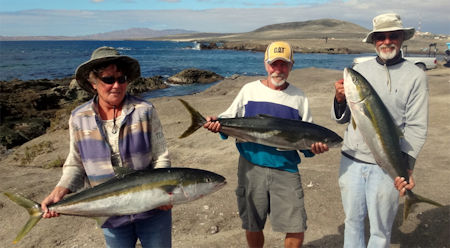
The fishing may be somewhat slower than normal in Los Cabos, but there is still some good action to be had by visiting anglers. Pisces Sportfishing reports, “Striped marlin have been the main offshore staple recently, but types of fish being caught are quite varied. A lot of inshore species and smaller gamefish are being caught, including red snapper, sheephead, grouper, sea bass, ladyfish and sierra mackerel.”
In San José del Cabo on the eastern side of the tip, Erik Bricston at Gordo Banks Pangas offers, “The ocean water temperatures have been holding firm in the 74 to 76 degree range, which is still warmer than usual for this time of year. Luckily, the wind conditions have been calm, which has provided the opportunity for the water clarity to improve, with blue water being found fairly close to shore. Our live bait supplies have also remained steady for caballitos, and strips of squid continue to be an effectively used for drift fishing while targeting the yellowfin tuna. The majority of the charters launching out of San José del Cabo area were fishing areas from Punta Gorda, Gordo Banks, Cardon and Iman Bank. Through much of the week the most productive place proved to be close to shore off of Punta Gorda.”
Bricston added, “All around, the action was a bit spotty; some days the bite would be early, some days late. Most common species caught was yellowfin tuna in the 10 to 30 lb. class, no huge numbers, but some charters were fortunate to land five or more tuna per trip.
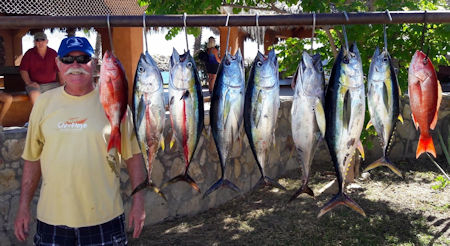
Caballito and the strips of squid was the main method that showed best results. There were a few larger yellowfin tuna still lurking late into the season around the Gordo Banks, but these fish were more finicky than the tuna found closer to shore. Not a tremendous variety of species now, only a few dorado being found, most of these closer to shore as well. The majority were of smaller size, though we saw a handful of dorado in the 20 lb. range.
Wahoo are still hanging around the region, though not many were being landed, they did not seem eager to strike on the normal type of lures or trap hooked baits, though many anglers told stories of having wahoo cut lines that were rigged with lighter mono leaders, which were needed to entice the line shy yellowfin.
Where the tuna action was centered close to shore there were various species of pargo and snapper mixed in, as well as the ever present triggerfish. The commercial fleet were doing well targeting the red snapper with fresh shrimp heads that they were able to obtain from shrimp trawlers passing through the area while on their way back to their home ports.”
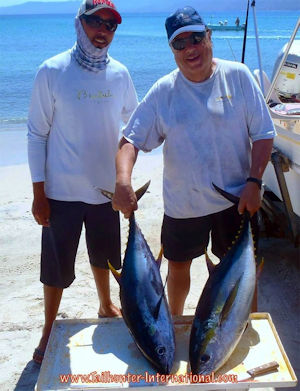
Bricston concluded, “While we heard of more striped marlin action being found on the Pacific Banks, we did not see much action for billfish off of San José del Cabo, only an occasional striper of sailfish. No signs of any sardina schools and this seems to be hurting any inshore fishing opportunities for sierra or roosterfish. A few decent sized roosterfish were hooked into off the beach stretches while trolling with caballito.”
Up the Cortez coast in La Paz, the weather has been a factor from time to time, but I can personally attest to the fact that there are still some quality fish hanging around the region. Jonathan Roldan at Tailhunter International reports, “We have had some of those windy wakes that made it pretty tough for fishing, with north winds blowing for a number of days. But that was just the bad news. The good news is that there have been many small windows of good weather that has allowed us some great fishing, and we were once again surprised by some of the catches. The crowds were light near the end of the year and there weren’t as many anglers around, since most folks either had their minds on the holidays, or were one of the visiting snowbirds simply enjoying some of the local sunshine.
However, right now we’re only fishing with our Tailhunter Las Arenas Fleet from Muertos Bay, where the fishing is more protected and closer to shore. In addition to the usual “winter fare” like snapper, pargo and cabrilla as well as bonito and skipjack, we are still hooking up with a few wahoo and even some dorado, which are generally fish we see when the weather and waters are warm. These dorado were not big but still…10 pounders are fun on light tackle and good eating and surely a surprise for someone who has never caught one before. And, no one ever argues with catching a wahoo either. Several were hooked and lost and a few brought to the boot were in the 20-25 pound class. Again, a total bonus on a fishing day when you’re not expecting it.”
While Baja California is a great place to visit virtually any time of year, it can be particularly welcoming during the months between January and March. The crowds are light and the current conversion rate provides exceptional values but, most importantly, Baja’s warm sun and arid climate can help to wash away all thought of the colder weather found much further to the north.

I purchased insurance through them & CHUBB for our trip to San Felipe. Unfortunately, we had to...

We use them every time we travel to Mexico. Luckily we have not needed their services yet but...

Excellent company who I've worked with for years. They are straightforward, helpful and offer very...